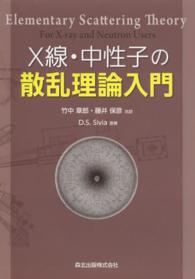- ホーム
- > 洋書
- > 英文書
- > Science / Mathematics
Full Description
This text is a historical-epistemological study of one the most consequential idea of early-modern celestial mechanics: Robert Hooke's proposal to "compoun[d] the celestial motions of the planets of a direct motion by the tangent & an attractive motion towards a central body," a proposal which Isaac Newton adopted and realized in his "Principia". Hook's "Programme" was revolutionary both cosmologically and mathematically. It presented "the celestial motions," the proverbial symbol of stability and immutability, as a process of continuous change, and prescribed only parameters of rectilinear motions and rectilinear attractions for calculating their closed curved orbits. Yet the traces of Hooke's construction of his "Programme" for the heavens lead through his investigations in such earthly disciplines as microscopy, practical optics and horology, and the mathematical tools developed by Newton to accomplish it appear no less local and goal-oriented than Hooke's lenses and springs.
This transgression of the boundaries between the theoretical, experimental and technological realms is reminiscent of Hooke's own free excursions in and out of the circles occupied by gentlemen-philosophers, university mathematicians, instrument makers, technicians and servants. It presents an opportunity to examine the social and epistemological distinctions, relations and hierarchies between those realms and their inhabitants, and compels a critical assessment of the philosophical categories they embody.






